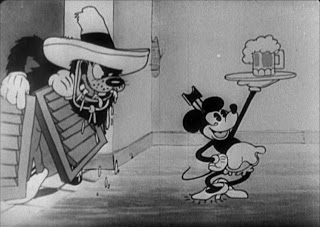Today’s cartoon actually sits neatly at an intersection of several things we’ve seen before. It is, in fact, the penultimate cartoon personally directed by Walt Disney; as established, he stopped for five years, then he decided to show his animators how to do it and directed the truly abysmal “The Golden Touch.” (It’s also the last short Ub Iwerks worked on before leaving the studio for a decade.) It’s a cartoon where Mickey starts showing more respect for Minnie than when he sexually assaults her in “Plane Crazy.” And in fact we get into a bit of the “how animal are these animals?” thing that the Goofy debate stems out of—a debate we know was resolved before he was called Goofy, because he was at that time Dippy Dawg.
Mickey (still Walt) is riding the still-unnamed Horace, then just sort of a horse. He arrives at a cantina, where Minnie (Marcellite Garner for the first time) is I believe a waitress. Anyway, there’s some singing and dancing. Then Mickey pulls her nose, and the fact that this is more respectful of her should tell you something about “Plane Crazy,” and Minnie understandably starts chucking things at him. More dancing follows, and then “Peg-Leg Pedro” (Pinto Colvig for the first time, also the first time with a peg leg) comes in and starts, well, acting not unlike “Plane Crazy” Mickey. But he’s the villain, so Mickey goes after him.
I’ll be honest, here—I picked this cartoon pretty well at random out of the Disney shorts of 1930. I have a site I use that lists them all for me, and I use it. Why wouldn’t you? I chose it because it looked like there would be plenty to say about it, and there is. In particular, there’s the fact that a lot of the sight gags of these early Mickey Mouse cartoons would not be out of place in Warners shorts—there’s even literally one here that I’ve seen repeatedly in Roadrunner cartoons, where a character gets concertinaed by a rock.
Also, you know, the shoot-out scene is surprisingly well filmed for a 1930 cartoon. The lights go out, and we see the whole thing in almost a negative version of itself. In flashes. Really, genuinely, this may be some of the best visuals of a cartoon from its era. Okay, I grant you, what you got from Warners in the same year was five Bosko shorts, and it’s not hard to be better than a Bosko short. And, okay, it’s four years after The Adventures of Prince Achmed, which has it beat cold. But certainly American animation, at least.
My sources show a little confusion over whether Garner actually voiced Minnie for the whole time. I found a quote from her that indicates that the studio may have actually hired a Mexican woman for the speaking part; Garner says they were asking in the Ink and Paint Department for someone who could speak Spanish, and she said she could read it. She said they’d been told that a Mexican woman was hired, but Garner did at least the singing, which for whatever reason the Mexican woman (I’d give her name if Garner had) wasn’t going to do—and fellow painter Marge Ralston wouldn’t, either.
This was several cartoons before they would start making Horace fully anthropomorphized. He’s still just a horse here. He is, I genuinely believe, the most underutilized character of the early Disney pantheon. Even now, ninety years after this cartoon was released, we essentially don’t have a developed character for him. He could be anything. I’m sure you can’t hear his voice; of course you can’t. He didn’t have an established voice until 1990’s “The Prince and the Pauper.” He’s on some of the cartoons my kids watch, but even with that I don’t remember him, because even there he hardly appears.
With very few exceptions, the shorts of this era are forgotten. Oh, 1930 wasn’t the best year the Walt Disney Studios had, though a few of the not-Mickey cartoons are lovely. This may well be my favourite era of Mickey, when he’s got some of the nastiness sanded off but not enough to be completely featureless. But of the forgotten ones, this may well be the best.
It’s been a very expensive week for me, and I really would love it if you could support my Patreon or Ko-fi!


